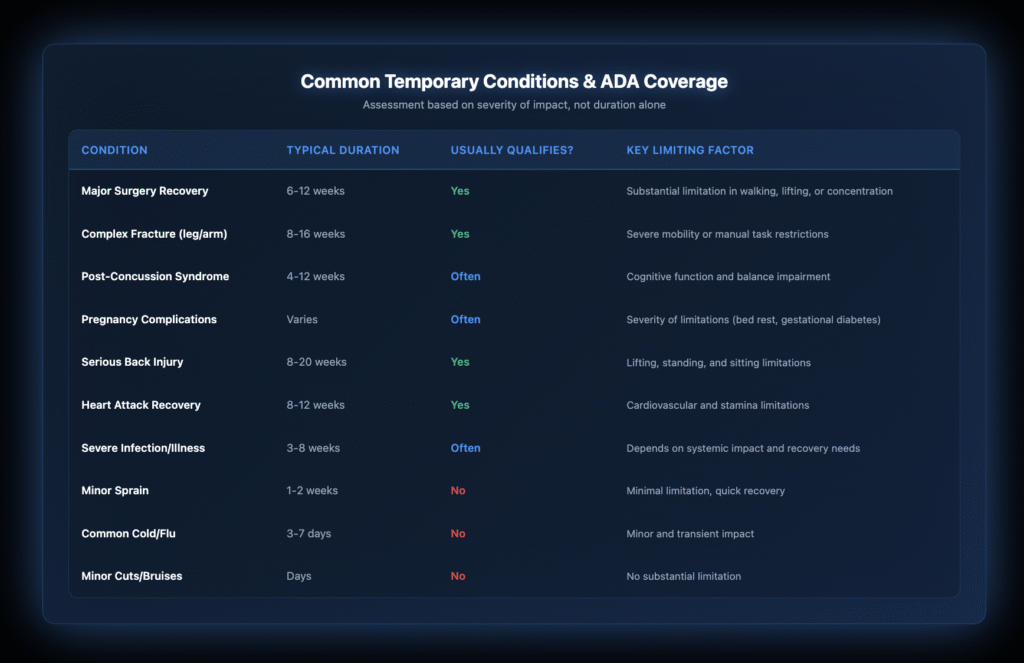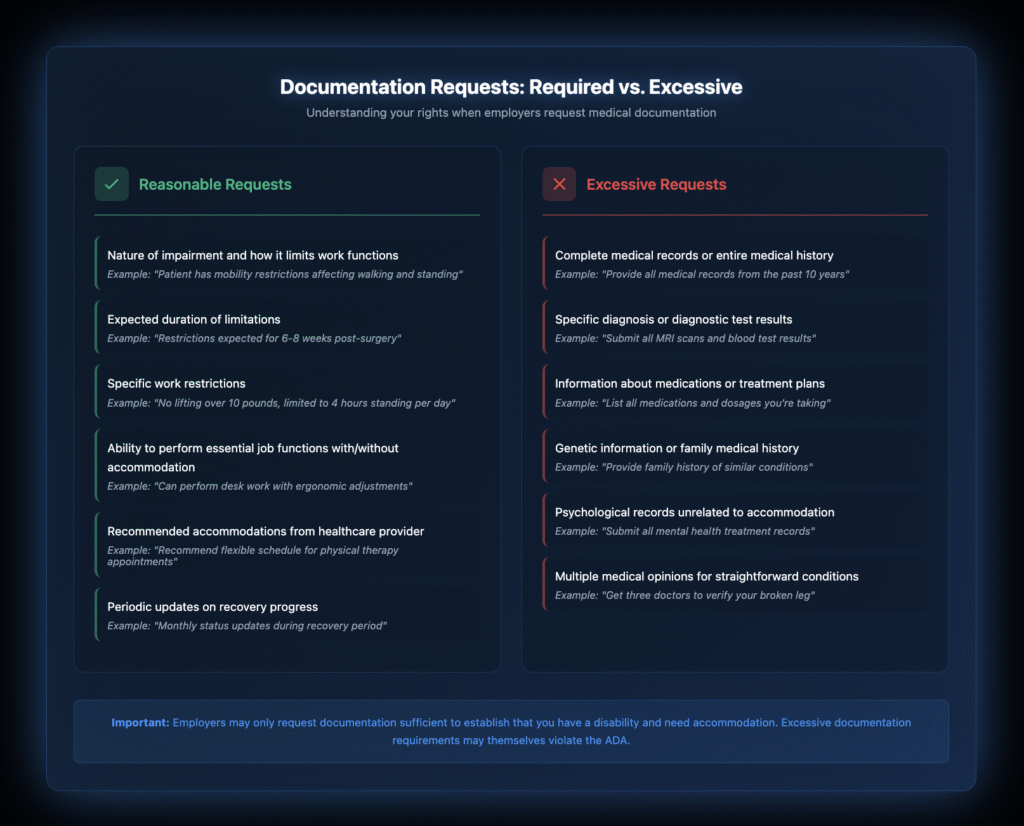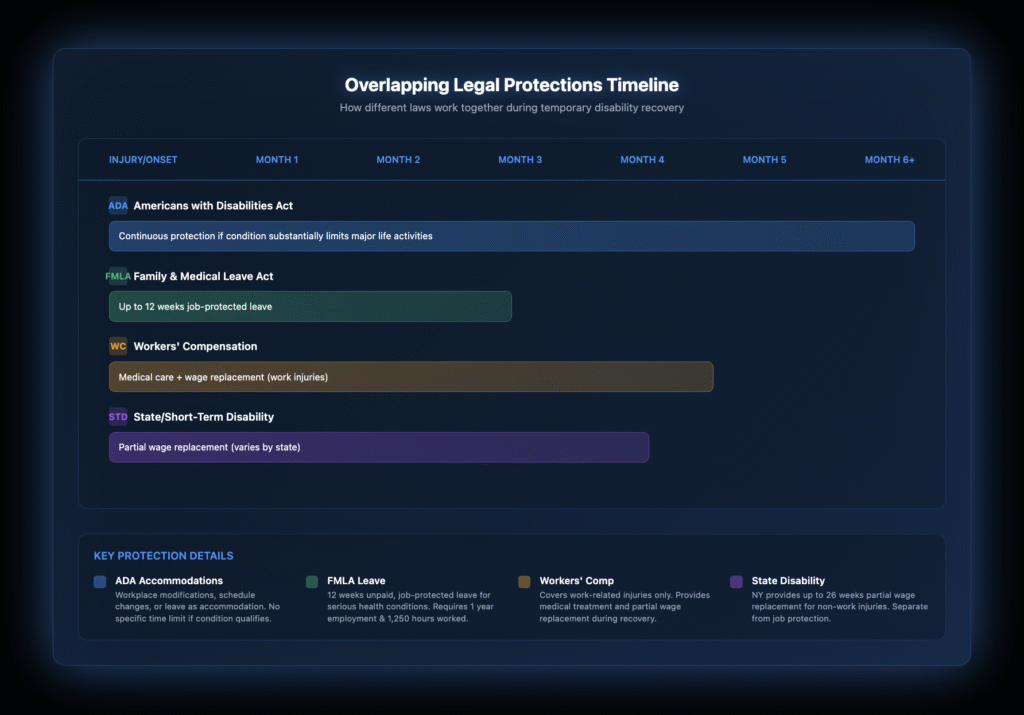Yes, temporary disabilities can qualify for full ADA protection when they substantially limit one or more major life activities—regardless of how long they’re expected to last. The U.S. Court of Appeals for the Ninth Circuit’s May 2022 ruling reinforced that conditions like surgery recovery, broken bones, and serious illnesses requiring weeks or months of healing may receive the same workplace accommodations as permanent disabilities. The key factor isn’t duration but impact: if your temporary condition significantly restricts your ability to walk, stand, lift, concentrate, or perform other essential activities, you’re likely entitled to reasonable accommodations under federal law.
What Are the Key Takeaways About Temporary Disabilities and ADA Rights?
- Severity matters more than duration: A temporary condition lasting weeks or months can qualify if it substantially limits major life activities.
- The 2008 ADA Amendments Act broadened protection: Courts must now interpret disability definitions broadly, favoring coverage for temporary impairments.
- Employers cannot automatically deny accommodations: Dismissing requests simply because a condition is temporary violates the ADA.
- Documentation is crucial: Medical evidence showing specific limitations and expected recovery time strengthens accommodation requests.
- Multiple laws may apply: Temporary disabilities often trigger ADA, FMLA, workers’ compensation, and state disability protections simultaneously.
- The interactive process is mandatory: Employers must engage in good-faith discussions about accommodations, even for short-term conditions.
Disclaimer: This article provides general information for informational purposes only and should not be considered a substitute for legal advice. It is essential to consult with an experienced employment lawyer at our law firm to discuss the specific facts of your case and understand your legal rights and options. This information does not create an attorney-client relationship.
How Does the ADA Define Disability for Temporary Conditions?
The Americans with Disabilities Act defines disability as “a physical or mental impairment that substantially limits one or more major life activities.” This definition applies equally to temporary and permanent conditions—there’s no minimum duration requirement in the statute.
The ADA Amendments Act of 2008 specifically instructed courts to interpret “disability” broadly. This expansion directly impacts temporary conditions by focusing the assessment on the severity of limitations rather than expected recovery time.
Major life activities encompass both daily functions and bodily operations. Walking, standing, lifting, seeing, hearing, speaking, breathing, learning, reading, concentrating, and thinking all qualify. The law also protects major bodily functions, including immune system operations, cell growth, digestive processes, and neurological functions.
Which Temporary Conditions Typically Qualify for ADA Protection?
Not every short-term ailment meets the disability threshold. Minor conditions like common colds, seasonal flu, or slight sprains that heal within days rarely qualify. The condition must create substantial limitations during its active period.

Recovery from major surgeries often qualifies, especially when mobility or concentration remains limited for several weeks. Complex fractures requiring months of healing typically meet ADA standards due to their substantial impact on walking or lifting abilities.
Pregnancy-related impairments present unique considerations. While pregnancy itself isn’t a disability, complications causing substantial limitations—such as severe morning sickness, gestational diabetes, or prescribed bed rest—may qualify for accommodations.
Post-surgical recovery periods vary widely but frequently warrant protection. Hip replacements, spinal surgeries, or cardiac procedures commonly limit major activities sufficiently to trigger ADA coverage.
What Makes a Temporary Condition "Substantially Limiting"?
The substantial limitation standard examines how severely a condition restricts major life activities compared to most people in the general population. This comparison occurs while the impairment is active, not based on long-term projections.
Courts evaluate several factors when determining a substantial limitation. The condition’s nature and severity carry significant weight. A broken ankle preventing walking for three months likely qualifies, while a twisted ankle healing in three days typically doesn’t.
Expected duration matters but isn’t determinative. The Ninth Circuit’s 2022 decision emphasized that temporary impairments lasting weeks or months can qualify when they significantly restrict activities during that period.
The breadth of activities affected also influences qualification. Conditions limiting multiple major life activities—like post-concussion syndrome affecting both concentration and balance—strengthen the case for ADA coverage.
What Reasonable Accommodations Can Employees Request for Temporary Disabilities?
Reasonable accommodations for temporary disabilities mirror those for permanent conditions but typically include defined endpoints aligned with recovery timelines.
How Can Work Schedules Be Modified?
Modified schedules accommodate many temporary limitations effectively. Part-time work during recovery helps employees maintain productivity while managing pain or fatigue. Flexible start times accommodate medical appointments or morning medication side effects.
Intermittent leave for treatments or therapy sessions provides necessary medical care without requiring extended absence. Gradual return-to-work schedules allow progressive increases in hours as recovery advances.
Which Physical Workspace Changes Help?
Temporary workspace modifications address mobility and comfort needs. Ground-floor workstations eliminate stair-climbing for those with leg injuries. Ergonomic equipment reduces strain during recovery from back surgeries or repetitive stress injuries.
Closer parking spaces minimize walking distances for employees with temporary mobility limitations. Standing desks or adjustable workstations accommodate those unable to maintain single positions for extended periods.
When Is Remote Work Appropriate?
Telework arrangements particularly benefit employees recovering from surgeries or managing conditions requiring frequent rest. Remote work eliminates commute challenges while maintaining productivity for positions where physical presence isn’t essential.
Technology enables virtual meeting participation when travel to the office proves difficult. Document sharing platforms and collaboration tools facilitate continued contribution despite temporary physical limitations.
How Should Employees Navigate the Interactive Process?
The interactive process creates a framework for identifying effective accommodations through employer-employee collaboration.
What Triggers the Process?
Either party can initiate discussions about accommodations. Employees typically begin by disclosing their temporary condition and requesting specific modifications. Employers should recognize potential needs even without formal requests—obvious limitations from crutches or surgical recovery warrant proactive engagement.
Initial requests don’t require specific legal language. Statements like “I need help with my job because of my medical condition” sufficiently trigger employer obligations to engage in accommodation discussions.
What Documentation Can Employers Request?
Employers may seek medical documentation confirming the temporary disability and its limitations. Appropriate documentation includes the condition’s nature without requiring specific diagnoses, functional limitations affecting work performance, and expected duration of restrictions.

Healthcare providers should specify work-related limitations rather than general medical information. Documentation stating “unable to lift over 10 pounds for 6 weeks following surgery” provides clearer guidance than broad statements about recovery needs.
How Often Should Accommodations Be Reviewed?
Temporary disabilities necessitate periodic reassessment as conditions evolve. Initial accommodations might require adjustment as recovery progresses or complications arise. Regular check-ins—perhaps biweekly or monthly—ensure accommodations remain appropriate.
Medical updates guide modification timing. Improved functionality might permit the gradual resumption of regular duties. Conversely, unexpected complications could necessitate extended or enhanced accommodations.
How Do Other Leave Laws Interact with Temporary Disability Accommodations?
Multiple legal protections often apply simultaneously to temporary disabilities, creating overlapping rights and obligations.
When Does FMLA Apply Alongside ADA?
The Family and Medical Leave Act covers serious health conditions requiring continuing treatment or causing incapacity for more than three consecutive days. Many temporary disabilities qualifying for ADA accommodations also meet FMLA criteria.
Key distinctions shape how these laws interact. FMLA applies only to employers with 50+ employees and employees with sufficient tenure and hours worked. It provides a specific 12-week leave entitlement rather than individualized accommodations.
The laws can work together—FMLA leave might serve as an ADA accommodation, or an employee might exhaust FMLA leave, then receive additional unpaid leave as an ADA accommodation if it doesn’t create undue hardship.
How Does Workers’ Compensation Coordinate?
Workplace injuries triggering workers’ compensation claims frequently involve temporary disabilities requiring ADA accommodations. Workers’ compensation provides medical treatment and wage replacement, while the ADA ensures workplace modifications enabling return to work.
Employers cannot refuse accommodations simply because an employee receives workers’ compensation benefits. Light-duty programs offered through workers’ compensation should comply with ADA requirements, avoiding discrimination against workers with temporary disabilities.
What Additional State Protections Apply?
New York State Human Rights Law covers employers with four or more employees, extending protection beyond the ADA’s 15-employee threshold. New York City Human Rights Law provides even broader coverage, explicitly protecting temporary disabilities regardless of duration.
State disability insurance programs offer wage replacement during recovery, but don’t address workplace accommodations. Employees should understand these benefits complement rather than replace ADA protections.
What Challenges Do Employees Face with Temporary Disability Accommodations?
How Can Employees Prove Substantial Limitation?
Demonstrating substantial limitations for invisible conditions proves particularly challenging. Post-concussion cognitive effects or pain from healing injuries might not appear obvious to observers. Detailed medical documentation becomes crucial for establishing limitations others cannot see.
Keeping symptom journals helps track daily limitations and their workplace impact. Recording specific instances where conditions prevented task completion strengthens accommodation requests.
What If Accommodation Needs Change During Recovery?
Recovery rarely follows linear paths. Setbacks require flexibility in accommodation approaches. Employees should communicate promptly about changing limitations rather than struggling with inadequate accommodations.
Documentation from follow-up medical appointments supports modification requests. Updated restrictions or extended recovery timelines warrant accommodation adjustments without restarting the entire interactive process.
How Should Multiple Benefit Programs Be Coordinated?
Navigating overlapping protections requires careful attention to different requirements and timelines. FMLA exhaustion doesn’t end ADA obligations. Workers’ compensation claim closure doesn’t eliminate accommodation needs.

Understanding each program’s unique provisions prevents gaps in protection. Employees should track deadlines and requirements for each applicable law.
What Are Employer Obligations for Temporary Disabilities?
Can Employers Automatically Deny Temporary Disability Accommodations?
No—employers must evaluate each temporary disability individually. Blanket policies refusing accommodations for conditions lasting less than six months violate the ADA. The Ninth Circuit’s 2022 ruling specifically rejected duration-based accommodation denials.
Assessment must focus on current limitations and accommodation feasibility. Even accommodations needed for just several weeks require good-faith consideration if the condition substantially limits major activities.
What Constitutes Undue Hardship for Temporary Accommodations?
Undue hardship analysis considers the accommodation’s nature and cost relative to the employer’s resources. Temporary accommodations might actually prove less burdensome than permanent modifications.
Short-term telework during recovery likely creates minimal hardship for office positions. Conversely, extended leave for a specialized position in a small business might constitute undue hardship if no temporary replacement exists.
Financial considerations include both direct costs and operational impacts. While purchasing temporary equipment might seem expensive, the limited duration reduces the overall burden compared to permanent modifications.
What Legal Remedies Exist for Temporary Disability Discrimination?
How Can Employees File Discrimination Complaints?
Employees facing discrimination based on temporary disabilities can file charges with the Equal Employment Opportunity Commission within 300 days of the discriminatory act in New York. State and city agencies offer additional filing venues with potentially longer deadlines.
Documentation proves critical for successful claims. Maintain records of accommodation requests, employer responses, medical documentation, and any adverse employment actions following disclosure of temporary disabilities.
What Damages Are Available?
Successful disability discrimination claims may yield various remedies. Back pay compensates for lost wages due to discriminatory termination or demotion. Front pay addresses future losses when reinstatement isn’t feasible.
Compensatory damages cover emotional distress and out-of-pocket expenses resulting from discrimination. Punitive damages may apply when employers demonstrate malice or reckless indifference to ADA rights.
Injunctive relief requires employers to provide denied accommodations or change discriminatory policies. Attorney’s fees ensure employees can pursue valid claims regardless of financial resources.
What Should You Do If Facing Temporary Disability Discrimination?
Document everything related to your condition, limitations, and employer interactions. Request accommodations in writing, specifying needed modifications and their connection to your temporary disability. Keep copies of all correspondence.
Follow internal complaint procedures while maintaining external filing deadlines. Company grievance processes don’t extend EEOC charge-filing periods. Pursue internal remedies simultaneously with administrative complaints when necessary.
Seek medical documentation clearly establishing your temporary disability and work limitations. Healthcare providers should understand workplace requirements to provide relevant, specific restriction information.
The evolving legal landscape increasingly recognizes temporary disability rights under the ADA. Recent judicial interpretations emphasize that duration doesn’t determine disability—impact does. This protection ensures equal opportunity during vulnerable recovery periods.
Understanding your rights empowers effective self-advocacy during temporary disability situations. While navigating overlapping legal protections proves complex, knowledgeable employees can secure necessary accommodations enabling continued productivity during recovery.
At Nisar Law Group, experienced attorneys understand the nuances of temporary disability discrimination cases. Whether seeking accommodations for surgery recovery or facing retaliation for requesting modifications during temporary impairment, professional legal guidance protects your workplace rights. Don’t let employers dismiss your temporary disability as insufficiently serious—contact us to discuss how the ADA’s broad protections apply to your situation.
Frequently Asked Questions About Temporary Disabilities and ADA Protection
Yes, temporary conditions can absolutely qualify as disabilities under the ADA when they substantially limit one or more major life activities. The key factor isn’t how long your condition lasts—it’s how severely it impacts you while you have it. A broken leg requiring three months of recovery that prevents you from walking normally qualifies for protection, while a minor cold lasting a week typically doesn’t. The 2022 Ninth Circuit ruling confirmed that employers cannot automatically deny accommodations just because a condition is temporary.
Common examples of temporary disabilities that often qualify for ADA protection include recovery from major surgery (6-12 weeks), complex bone fractures requiring months of healing, severe back injuries limiting lifting and mobility, post-concussion syndrome affecting concentration and balance, and pregnancy complications requiring bed rest. Even mental health conditions with acute episodes, like severe depression following a traumatic event, can qualify as temporary disabilities if they substantially limit major life activities during the episode.
Minor, short-term conditions that don’t substantially limit major life activities typically don’t qualify as disabilities. These include common colds or seasonal flu lasting a few days, minor sprains or strains healing within a week, small cuts or bruises, mild headaches, or temporary stomach upset. The condition must create a significant limitation compared to most people in the general population—minor inconveniences or discomfort alone won’t meet the ADA threshold.
No, the ADA and short-term disability insurance serve completely different purposes. The ADA is a federal civil rights law requiring employers to provide reasonable accommodations and prohibiting discrimination—it keeps you working or helps you return to work with modifications. Short-term disability (STD) is typically an insurance benefit providing partial wage replacement when you can’t work due to illness or injury. You can receive STD benefits while also being protected by the ADA, and many employees use both simultaneously during recovery.
To prove your temporary condition qualifies as an ADA disability, you’ll need medical documentation showing: (1) the specific nature of your impairment, (2) which major life activities are substantially limited (walking, lifting, concentrating, etc.), (3) how severely these activities are restricted compared to most people, and (4) the expected duration of limitations. Keep detailed records of how your condition affects daily work tasks, get clear work restrictions from your doctor (like “no lifting over 10 pounds for 8 weeks”), and document all accommodation requests and employer responses in writing.
Yes, temporary disabilities are real and increasingly recognized by courts as deserving full ADA protection. Any physical or mental impairment that substantially limits major life activities qualifies as a disability under the ADA, regardless of whether it’s permanent or temporary. Federal courts have repeatedly ruled that conditions lasting weeks or months—like recovery from surgery, broken bones, or serious illnesses—can receive the same accommodations and protections as permanent disabilities when they create substantial limitations during their duration.
Temporary disabilities commonly arise from workplace injuries requiring extended recovery, major surgeries (hip replacement, spinal procedures, cardiac operations), serious accidents resulting in fractures or traumatic brain injuries, pregnancy complications, cancer treatments causing severe side effects, acute mental health episodes, severe infections or illnesses requiring lengthy recovery, or flare-ups of chronic conditions that temporarily worsen. The cause matters less than the impact—any condition severely limiting your major life activities for weeks or months may qualify for ADA protection.


